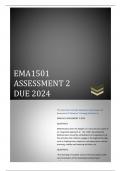Exam (elaborations)
EMA1501 Assessment 02 Due 2024. for assistance 0.7.2.5.3.5.1.7.6.4...This document includes Questions and Answers for Assessment 2 Question 1 through Question 4. EMA1501 ASSESSMENT 2 2024 QUESTION 1 Mathematics does not happen in a vacuum but
- Course
- EMA1501
- Institution
- University Of South Africa (Unisa)
EMA1501 Assessment 02 Due 2024. for assistance 0.7.2.5.3.5.1.7.6.4...This document includes Questions and Answers for Assessment 2 Question 1 through Question 4. EMA1501 ASSESSMENT 2 2024 QUESTION 1 Mathematics does not happen in a vacuum but is part of an integrated approach to the child’...
[Show more]



